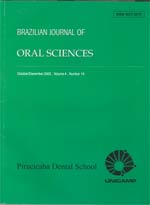
|
Brazilian Journal of Oral Sciences
Piracicaba Dental School - UNICAMP
EISSN:
Vol. 12, No. 2, 2013, pp. 138-142
|
 Bioline Code: os13028
Bioline Code: os13028
Full paper language: English
Document type: Research Article
Document available free of charge
|
|
|
Brazilian Journal of Oral Sciences, Vol. 12, No. 2, 2013, pp. 138-142
| en |
Effectiveness of different obturation techniques in surpassing the ledge formed in simulated curved canals
Gabardo, Marilisa Carneiro Leão; da Silva, Wander José; Machado Gonçalves, Letícia & Deonízio, Marili Doro Andrade
Abstract
Aim: To compare the effectiveness of different obturation techniques in surpassing the ledge
formed in simulated curved root canals.
Methods: Eighty acrylic-resin blocks with curved canals
were instrumented with Gates-Glidden drills to simulate a ledge formation. Then, a K-File #10 was
used for trying to surpass the deviation, and the blocks that permitted surpassing were rejected.
The remaining blocks were divided into 4 groups according to the obturation technique: lateral
condensation, Tagger’s Hybrid technique, Thermafil and System B. The blocks had their images
digitalized using a scanner before and after the obturation procedures. The images were analyzed
with Image Tool 3.0 software. Statistical analysis was performed by one-way ANOVA at a significant
level of 5%.
Results: The System B resulted in the highest obturated area (p<0.001). There
were no significant differences between the Tagger’s Hybrid technique and Thermafil system
regarding the effectiveness in surpassing ledge (p>0.05). The lateral condensation resulted in the
worst ability in filling the ledge space (p<0.001).
Conclusions: Within the limitations of this study,
it was possible to conclude that techniques using heat condensation or gutta-percha
thermoplastification were more effective in surpassing the ledge formed in curved canals than the
lateral condensation.
Keywords
endodontics, root canal therapy, root canal obturation, root canal filling materials
|
| |
© Copyright 2013 - Brazilian Journal of Oral Sciences
Alternative site location: http://www.fop.unicamp.br/brjorals
|
|
